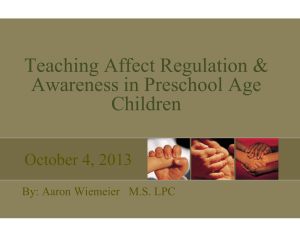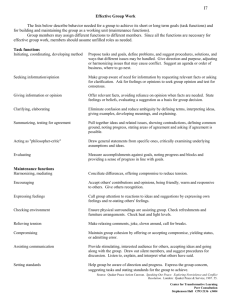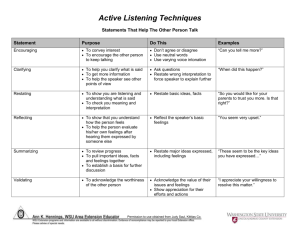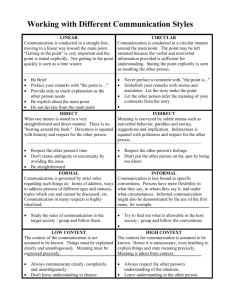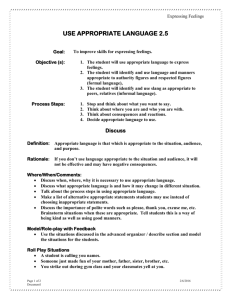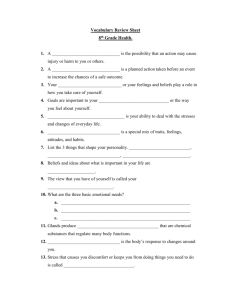Chapter 5 Communications in Intimate Relationships
advertisement
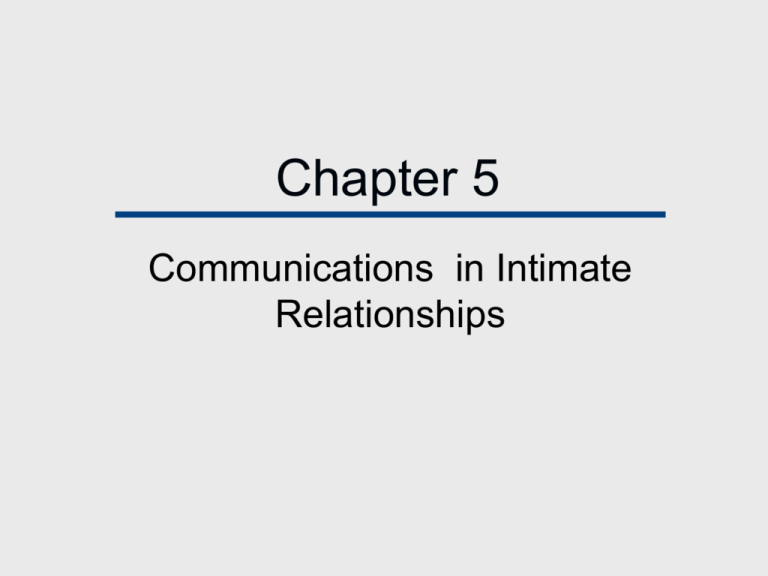
Chapter 5 Communications in Intimate Relationships Chapter Outline • Good Communication: A Basic Strength of Successful Families • What Causes Communication Failure? • The Foundation Blocks of Successful Communication Chapter Outline • Developing a Smooth Flow of Communication • Communication Skills Men and Women: Do They Speak the Same Language? • Communication and Family Conflict • Family Life in the Information Age Communication • Communication is the sending and receiving of messages, intentional and unintentional, verbal and nonverbal. • Communication is basic to every human relationship. Factors Related to Communication: • Trusting and confiding in one another • Trying new ways to deal with problems • Working together to solve problems • Expressing caring and affection for each other daily Factors Related to Communication: • At least one family member talking to his/her parents regularly • Sharing feelings and concerns with close friends • Parents spending time with teenagers for private talks • Checking in and out with each other The Foundation Blocks of Successful Communication 1. 2. 3. Commitment: The partners must be committed to make their relationship healthy and strong. Growth orientation: The partners must accept the fact that their relationship will always be dynamic and changing, rather than static. Noncoercive atmosphere: The partners must feel free to be themselves, to be open, and to be honest. The Principle of Least Interest The principle of least interest assumes that the one who cares the least controls the relationship. Communication Skills • Communication Motivation: A felt need to communicate • Communication Skill: The ability to accomplish one’s communication goals • Communication Behavior: Verbal and nonverbal actions that a person takes to accomplish his/ her goals Identifying Problem Ownership Clarifying responsibility, or problem ownership, is an important first step in problem-solving communication. Self-assertion Self-assertion is the process of recognizing and expressing one’s feelings, opinions, and attitudes while remaining aware of the feelings and needs of others. Johari Window Empathic Listening Empathy means not only understanding what the speaker is saying, but also responding to and feeling the speaker’s nonverbal communications and emotions. Nonverbal Communication If we are to be good listeners, part of our attention needs to be directed to the nonverbal communications of the speaker, often referred to as body language. Negotiating In negotiation, the partners alternate between self-assertion and empathic listening. Problem Solving 1. Recognize and define the problem. 2. Set up conditions supportive of problem solving. 3. Brainstorm for possible alternatives (establishing hypotheses). Problem Solving 4. Select the best solution. 5. Implement the solution. 6. Evaluate the solution. 7. Modify the solution, if necessary. Brainstorming The purpose of brainstorming is to produce as many ideas as possible within a given time period in an effort to solve a problem. Conflict-Causing Communication Strategies • • • Denial: when one partner does not acknowledge the problem. Disqualification: when the person intends to cover an emotion and deny that a real conflict exists. Displacement: the person places emotional reactions somewhere other than the real conflict source. Conflict-Causing Communication Strategies • Disengagement: family members avoid conflict simply by avoiding one another. • Pseudomutuality: Family members appear to be perfectly happy and delighted with each other. In this style of anger, no hint of discord is ever allowed to spoil the image of perfection. Topics of Conflict Handling money, dividing household tasks, relative relationships, jobs, social activities, alcohol use, moodiness, handling anger, and children all appear to be possible areas of conflict for many couples. Quick Quiz 1. The ability to accomplish one’s communication goals is a) b) c) d) Communication Behavior Communication Motivation Communication Skill Commitment Answer: c • The ability to accomplish one’s communication goals is called communication skill. 2. According to the text, this is basic to every human relationship. a) b) c) d) Commitment Growth Trust Communication Answer: d • Communication is basic to every human relationship. 3. The process of recognizing and expressing one’s feelings, opinions, and attitudes while remaining aware of the feelings and needs of others is a) b) c) d) Commitment Self-assertion Communication Problem Ownership Answer: b • Self-assertion is the process of recognizing and expressing one’s feelings, opinions, and attitudes while remaining aware of the feelings and needs of others.

